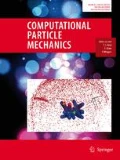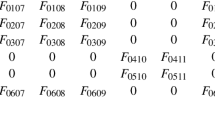Abstract
This paper communicates the results of a synergistic investigation that initiates our long term research goal of developing a continuum model capable of predicting a variety of granular flows. We consider an ostensibly simple system consisting of a column of inelastic spheres subjected to discrete taps in the form of half sine wave pulses of amplitude a/d and period \(\tau \). A three-pronged approach is used, consisting of discrete element simulations based on linear loading-unloading contacts, experimental validation, and preliminary comparisons with our continuum model in the form of an integro-partial differential equation.














Similar content being viewed by others
Notes
The sharp gradient up to this peak is due to the scale of the horizontal axis.
The choice to utilize continuous vibration, as opposed to discrete taps, arises from the fact that as the number of particles in our system is altered, the motion of the oscillating base used to excite particles may be influenced by the varying mass, resulting in an unequal provision of energy to the different systems, and hence a lack of consistency in our results. The use of continuous vibrations allows feedback from an accelerometer to be used in order to ensure a driving strength which is consistent to within 0.1 % in all cases.
The number of repeated runs for the three-dimensional systems was limited to this value due to the considerable amount of time required for the highest-N runs combined with the costs associated with the use of the PEPT facility. It should be noted, however, that the minimal variance observed in the data for our 3D systems (see Fig. 10) indicates that the number of runs conducted was indeed adequate to produce good statistics.
References
Valverde JM, Castellanos A (2007) Compaction of fine powders: from fluidized agglomerates to primary particles. Granul Matter 9(1–2):19–24
Rosato AD, Dybenko O, Ratnaswamy V, Horntrop D, Kondic L (2010) Microstructure evolution in density relaxation by tapping. Phys Rev E 81:061301
Richard P, Philippe P, Barbe F, Bourles S, Thibault X, Bideau D (2003) Analysis by x-ray microtomography of a granular packing undergoing compaction. Phys Rev E 68(2):020301
Richard P, Nicodemi M, Delannay R, Ribiere P, Bideau D (2005) Slow relaxation and compaction of granular systems. Nat Mater 4(2):121–128
Luding S, Nicolas M, Pouliquen O (2000) A minimal model for slow dynamics: compaction of granular media under vibration or shear. In: Kolymbas D, Fellin W (eds) Compaction of soils, granulates and powders. A. A. Balkema, Rotterdam, p 241
Linz S, Dohle A (1999) Minimal relaxation law for compaction of tapped granular matter. Phys Rev E 60(5):5737–5741
Dobry R, Whitman RV (1973) Compaction of sand on a vertically vibrated table. American Society of Testing Materials, Philadelphia
Ayer JE, Soppet FE (1965) Vibratory compaction: I, compaction of spherical shapes. J Am Ceram Soc 48(4):180
Wildman RD, Parker DJ (2002) Coexistence of two granular temperatures in binary vibrofluidized beds. Phys Rev Lett 88(6):064301
Wildman RD, Huntley JM, Parker DJ (2001) Granular temperature profiles in three-dimensional vibrofluidized granular beds. Phys Rev E 63(6 I):061311
Warr S, Huntley JM, Jacques GTH (1995) Fluidization of a two-dimensional granular system: experimental study and scaling behavior. Phys Rev E 52(5):5583–5595
Wakou J, Ochiai A, Isobe M (2008) A Langevin approach to one-dimensional granular media fluidized by vibrations. J Phys Soc Jpn 77(3):034402
Brey JJ, Ruiz-Montero MJ, Moreno F, Garcia-Rojo R (2002) Transversal inhomogeneities in dilute vibrofluidized granular fluids. Phys Rev E 65(6):061302
Yoon DK, Jenkins JT (2006) The influence of different species’ granular temperatures on segregation in a binary mixture of dissipative grains. Phys Fluids 18(7):073301:073303–073306
Windows-Yule CR, Parker DJ (2015) Density-driven segregation in binary and ternary granular systems. Kona Powder Particle 32:163–175. doi:10.14356/kona.2015004
Williams JC (1976) The segregation of particulate materials: a review. Powder Technol 15:245–251
Vanel L, Rosato AD, Dave RN (1997) Rise regimes of a single large sphere in a vibrated bed. Phys Rev Lett 78:1255–1258
Shishodia N, Wassgren CR (2001) Particle segregation in vibrofluidized beds due to buoyant forces. Phys Rev Lett 87(8):084302
Sanders DA, Swift MR, Bowley RM, King PJ (2006) The attraction of Brazil nuts. Europhys Lett 73(3):349–355
Rosato AD, Blackmore DL, Zhang N, Lan Y (2002) A perspective on vibration-induced size segregation of granular materials. Chem Eng Sci 57(2):265–275
Poschel T, Herrmann HJ (1995) Size segregation and convection. Europhys Lett 29(2):123–128
Metzger MJ, Remy B, Glasser BJ (2011) All the Brazil nuts are not on top: vibration induced granular size segregation of binary, ternary and multi-sized mixtures. Powder Technol 205(1–3):42–51
Liffman K, Muniandy K, Rhodes M, Gutteridge D, Metcalfe G (2001) A segregation mechanisms in vertically shaken bed. Granul Matter 3:205–214
Huerta DA, Ruiz-Suarez JC (2004) Vibration-induced granular segregation: a phenomenon driven by three mechanisms. Phys Rev Lett 92(11):114301–114301
Harwood CF (1977) Powder segregation due to vibration. Powder Technol 16:51–57
Ellenberger J, Vandu CO, Krishna R (2006) Vibration-induced granular segregation in a pseudo-2D column: the (reverse) Brazil nut effect. Powder Technol 164(3):168–173
Duran J, Rajchenbach J, Clement E (1993) Arching effect model for particle size segregation. Phys Rev Lett 70:2431–2434
Ahmad K, Smalley IJ (1973) Observation of particle segregation in vibrated granular systems. Powder Technol 8:69–75
Bonneau L, Andreotti B, Clement E (2007) Surface elastic waves in granular media under gravity and their relation to booming avalanches. Phys Rev E 75(1):016602. doi:10.1103/PhysRevE.75.016602
Conway SL, Coldfarb DJ, Glasser BJ (2003) Free surface waves in wall-bounded granular flows. Phys Rev Lett 90(7):074301
Luding S (1997) Surface waves and pattern formation in vibrated granular media. In: Behringer R, Jenkins JT (eds) Powders and grains 1997. A. A. Balkema, Amsterdam
Pak HK, Behringer PR (1993) Surface waves in vertically vibrated granular materials. Phys Rev Lett 71(12):1835–1838
Blackmore D, Rosato A, Tricoche X, Urban K, Zuo L (2014) Analysis, simulation and visualization of 1D tapping via reduced dynamical systems models. Physica D 273–74:14–27. doi:10.1016/j.physd.2014.01.009
Blackmore D, Rosato A, Tricoche X, Urban K, Ratnaswamy V (2011) Tapping dynamics for a column of particles and beyond. J Mech Mater Struct 6(1–4):71–86. doi:10.2140/jomms.2011.6.71
Dybenko O, Rosato AD, Horntrop D (2007) Three-dimensional Monte Carlo simulations of density relaxation. Kona Powder Particle 25:133–144
Falcon E, Laroche C, Fauve S, Coste C (1998) Collision of a 1-D column of beads with a wall. Eur Phys J B 5(1):111–131
Cundall PA (1974) Rational design of tunnel supports: a computer model for rock-mass behavior using interactive graphics for input and output of geometrical data. U. S. Army Corp. of Engineers, Omaha
Cundall PA, Strack ODL (1979) A discrete numerical model for granular assemblies. Geotechnique 29(1):47–65
Alder BJ, Wainwright TE (1956) Statistical mechanical theory of transport properties. In: Proceedings of the international union of pure and applied physics, Brussels
Alder BJ, Wright TEWA (1960) Studies in molecular dynamics. II. Behavior of a small number of elastic spheres. J Chem Phys 33(5):1439–1451
Walton OR, Braun RL (1993) Simulation of rotary-drum and repose tests for frictional spheres and rigid sphere clusters. In: Joint DOE/NSF worksop on flow of particulates and fluids, Ithaca
Walton OR, Braun RL (1986) Stress calculations for assemblies of inelastic spheres in uniform shear. Acta Mech 63(1–4):73–86
Walton OR (1992) Numerical simulation of inelastic, frictional particle-particle interactions. In: Roco MC (ed) Particulate two-phase flow. Butterworths, Boston, pp 884–911
Goldsmith W (1960) Impact: the theory and physical behavior of colliding solids. Edward Arnold, London
Dintwa E, Tijskens E, Ramon H (2008) On the accuracy of the Hertz model to describe the normal contact of soft elastic spheres. Granul Matter 10(3):209–221
Parker D, Forster R, Fowler P, Takhar P (2002) Positron emission particle tracking usingthe new Birmingham positron camera. Nucl Instr Methods Phys Res A 477:540–545
Wildman RD, Huntley JM, Hansen JP, Parker DJ, Allen DA (2000) Single-particle motion in three-dimensional vibrofluidized granular beds. Phys Rev E 62(3 B):3826–3835
Windows-Yule CR, Rosato AD, Rivas N, Parker DJ (2014) Influence of initial conditions on granular dynamics near the jamming transition. New J Phys 16:063016
Wildman RD, Huntley JM, Parker DJ (2001) Convection in highly fluidized three-dimensional granular beds. Phys Rev Lett 86:3304–3307
Windows-Yule CR, Rivas N, Parker DJ (2013) Thermal convection and temperature inhomogeneity in a vibrofluidized granular bed: the influence of sidewall dissipation. Phys Rev Lett 111:038001
Windows-Yule C, Weinhart T, Parker DJ, Thornton AR (2014) Effects of packing density on the segregative behaviors of granular systems. Phys Rev Lett 112:098001
Jenkins JT, Zhang C (2002) Kinetic theory for identical, frictional, nearly elastic spheres. Phys Fluids 14(3):1228–1235
McNamara S, Young WR (1994) Inelastic collapse in two dimensions. Phys Rev E 50(1):R28–R31
Blackmore D, Samulyak R, Rosato A (1999) New mathematical model for particle flow dynamics. J Nonlinear Math Phys 6:198–221
Blackmore D, Urban K, Rosato A (2010) Integrability analysis of regular and fractional BSR fields. Condens Matter Phys 13(43403):1–7
Wu H, Blackmore D (2015) Global well-posedness of the BSR model. In preparation
Stirkwerda JC (2004) Finite difference schemes and particle differential equations. SIAM, Philadelphia
Tadmor E (2002) Stability of Runga-Kutta schemes by the energy method. In: Estep D, Tavener S (eds) Collected lectures on the preservation of stability under discretization. SIAM, Philadelphia, pp 25–48
Acknowledgments
The work of the NJIT group was supported in part by NSF Grant CMMI-1029809. Experiments conducted at the University of Birmingham were made possible through financial support provided by the Hawkesworth Scholarship, set up by the late Dr. Michael Hawkesworth.
Author information
Authors and Affiliations
Corresponding author
Rights and permissions
About this article
Cite this article
Rosato, A.D., Zuo, L., Blackmore, D. et al. Tapped granular column dynamics: simulations, experiments and modeling. Comp. Part. Mech. 3, 333–348 (2016). https://doi.org/10.1007/s40571-015-0075-2
Received:
Revised:
Accepted:
Published:
Issue Date:
DOI: https://doi.org/10.1007/s40571-015-0075-2





